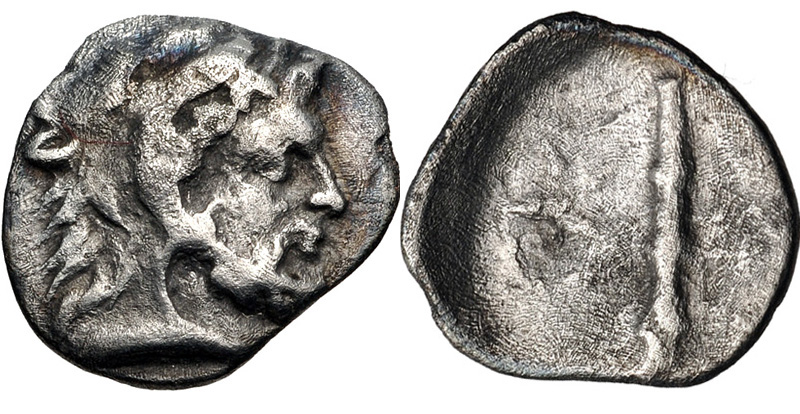H 178 - Lacedaemon (Areus I), silver, obols (266-264 BCE)
From SILVER
266 BCE - 264 BCE Silver 346 kg
Description
| ObverseInscription or printing placed on the obverse.: | Head of Heracles right, bearded, wearing Nemean lion skin headdress. |
| ReverseInscription or printing placed on the reverse.: | Club, five-rayed stars flanking. |
Mint and issuing power
| MintIdentifies the place of manufacture or issue of a numismatic object.: | Lacedaemon | Ancient regionAncient region.: | Peloponnesus (Laconia) | Modern countryModern country: Greece | AuthorityIdentifies the issuing power. The authority can be "pretended" when the name or the portrait of X is on the coin but he/she was not the issuing power. It can also be "uncertain" when there is no mention of X on the coin but he/she was the issuing power according to the historical sources: | Areus I of Sparta (Agiad King of Sparta, 309-265 BC) |
Chronology
| FromIdentifies the initial date in a range assigned in a numismatic context. | 266 BCE | toIdentifies the final date in a range assigned in a numismatic context.. | 264 BCE | PeriodTime period of the numismatic object.: Hellenistic 323-30 BC |
Physical description
| MetalThe physical material (usually metal) from which an object is made.: | Silver |
Median weightMedian of the weights of numismatic objects (in grams). in grams | 0.90 | DenominationTerm indicating the value of a numismatic object. Examples: tetradrachm, chalkous, denarius.: | obol |
StandardStandard.: |
Image

H178 Areus .jpeg [1]
References
| Die study referencePublication of the study: | S. Grunauer-von Hoerschelmann1S. Grunauer-von Hoerschelmann, Die Münzprägung der Lakedaimonier, AMUGS 7, Berlin, 1978. | ||
| Coin series referenceReference to coin series study: | RQEMH2RQEMH, n° 178 | ||
Reverse dies distribution
no distribution is available
Quantification
| Number of obversesNumber of obverse dies. ᵖ (o) | 8 | Number of singletons (o1)The number of singleton coins. ᵖ | 7 |
| Number of reverse diesNumber of reverse dies. (r) | 7 | Number of coinsNumber of coins. (n) | 12 |
| Coins per obverse dieNumber of coins per obverse die. (n/o) | 1.5 | Coins per reverse dieNumber of coins per reverse die. (n/r) | 1.71 |
| Reverse per obverse ratioRatio of obverse dies divided by reverse dies. (r/o) | 0.88 | Percentage of singletons (o1)number of coins (n) divided by the number of singletons (o1) ᵖ | 87.5 % |
| Original number of dies (O) (Carter 1983 formula)The estimation of the number of coins according to Carter 1983 ᵖ | 19.23 | Coins struck if 20,000 as average productivity per dieCoins made if the average productivity for obverses (according to Carter) is 20,000. ᵖ | 384,600 |
| Original number of dies (O) (Esty 2011 formula)The estimation of the number of coins according to the singleton formula in Esty 2011 ᵖ (O) | 24 | Survival rate if 20,000 as average productivity per dieSurvival rate if average productivity is 20,000. ᵖ | 0.00003 |
| Coverage (o = % of O) (Esty 1984 formula)Esty 1984 - coverage (% of O) ᵖ (o = % of O) | 41.67% | Die productivity if survival rate 1/2,000Average productivity if survival rate is 1/2,000. ᵖ | 1,248.05 |
| Weight of silver (in kg) if 20,000 coins per die (O = Carter formula)Carter 1983 * Median weight * 20000 (*10 if gold or electrum) ᵖ | 346 kg <br /> 346 kg | Die productivity if survival rate 1/5,000Average productivity if survival rate is 1/5,000. ᵖ | 3,120.12 |
Remarks
Most likely one single workstation